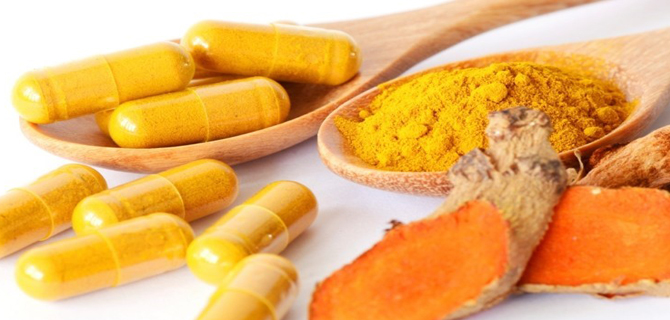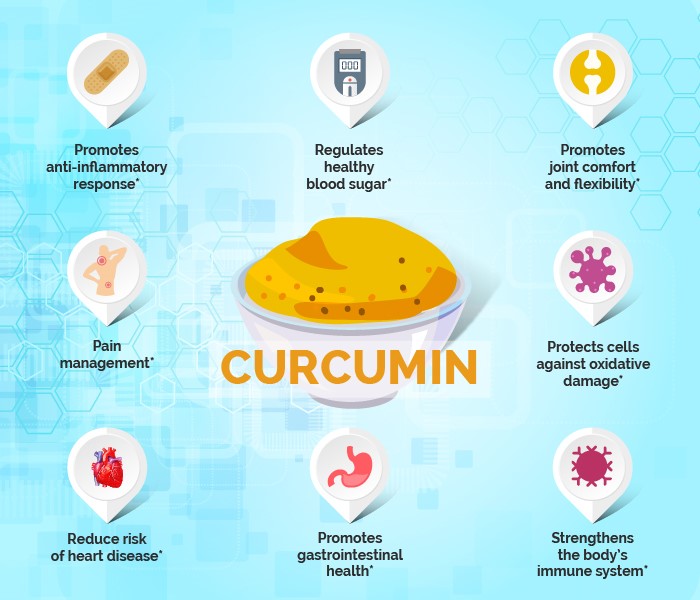
Turmeric is a spice widely used throughout Asia and a main ingredient in curries. Due to its yellow color, it’s sometimes referred to as Indian saffron. What’s more, its extensive use in traditional medicine has raised significant interest in its health benefits. Curcumin is the key active ingredient in turmeric.
This post looks at the benefits of and key differences between turmeric and curcumin, and how to supplement with them.
What is Curcumin?
Turmeric comes from the root of Curcuma longa, a flowering plant of the ginger family.It’s often sold in spice jars. However, if bought fresh, it looks similar to ginger root with a more intense yellow to golden color. In India, turmeric is used to treat skin conditions, digestive issues and aches and pains. In fact, it’s a staple of Ayurvedic medicine, a form of traditional healing. Turmeric contains many plant substances, but one group, curcuminoids, has the greatest health-promoting effects. Three notable curcuminoids are curcumin, demethoxycircumin and bisdemethoxycurcumin. Of these, curcumin is the most active and most beneficial to health.
Curcumin, which represents about 2–8% of most turmeric preparations, gives turmeric its distinct color and flavor. In its own right, curcumin is known for its anti-inflammatory, anti-tumor and antioxidant effects.
Benefits of Curcumin
Turmeric and curcumin have medicinal properties that provide many health benefits. Here are some of the areas in which both turmeric and curcumin have shown clear benefits, backed by science:
- Osteoarthritis: Plant compounds in turmeric that include curcumin can reduce markers of inflammation and thus relieve osteoarthritis symptoms.
- Obesity: Turmeric and curcumin may inhibit the inflammatory pathway involved in obesity and may help regulate body fat.
- Heart disease: Turmeric and curcumin can reduce “bad” LDL cholesterol and triglycerides and reduce the risk of heart disease as a result.
- Diabetes: Turmeric and curcumin can improve blood sugar metabolism and potentially reduce the effects of diabetes on your body.
- Liver: A rat study found that turmeric extract and curcumin were protective against chronic liver damage by helping reduce harmful oxidative stress.
- Cancer: Though research is still in its early stages, turmeric and curcumin may reduce the activity of colon and other cancer cells.
- Antifungal: Turmeric and curcumin can disrupt fungal cell membranes and could be used in conjunction with fungal medication for better outcomes.
- Antibacterial: Turmeric and curcumin have strong antibacterial effects. They can reduce the growth of many disease-causing bacteria.
Turmeric is a plant that has gained a lot of respect in the medical world. Not only is it good for arthritis, but it may also protect your brain as you age. It shows promise in the treatment of Parkinson’s disease. Turmeric contains various plant compounds that work together to support your body. A study that looked at the antifungal activity of turmeric found that all eight of its components, including curcumin, were able to inhibit fungal growth. The study also showed that curdione in turmeric had the best inhibitory effect. However, when combined with the seven other components, its fungal growth inhibition was even stronger. Therefore, though curcumin alone can reduce fungal growth. However, since turmeric contains curcumin, it’s hard to determine if turmeric is better than curcumin when it comes to other health conditions. More studies are needed that directly compare the effects of each.
Why curcumin may be more beneficial than turmeric?
As curcumin is considered the most active ingredient in turmeric, researchers have begun to isolate it and examine whether it could benefit certain conditions on its own. It has been shown to have strong anti-inflammatory and antioxidant effects and can even support wound healing through its antibacterial effects. What’s more, both turmeric and curcumin have been found to reduce blood sugars in type 2 diabetes. However, an animal study determined that curcumin was better at minimizing diabetes markers than turmeric. Curcumin can specifically lower inflammatory markers such as tumor necrosis factor (TNF) and interleukin 6 (IL-6), which are key contributors to type 2 diabetes. Additional studies are needed that compare the effects of turmeric and curcumin in people with type 2 diabetes. These are not the only health benefits of curcumin. It may also reduce osteoporosis risk. One animal study found that rats who received turmeric extracts enriched with curcumin-like curcuminoids had preserved bone mass, whereas those who had a lower amount of added curcuminoids showed no effect. However, curcumin is often poorly absorbed and can pass through your gut undigested. A helpful tip is to add some black pepper to your meals or supplements that contain curcumin. A substance in black pepper called piperine can increase the bioavailability of curcumin by 2,000%.

Which Should You Choose?
Most studies that have shown beneficial effects have used extracted turmeric with a high concentration of curcumin or curcumin alone. When choosing a supplement, it’s important to buy a formula that has been proven to be well absorbed (like BE YOUNG™ - Curcumin C3 Complex Plus™ Food Pills ). Curcumin is considered to be well-tolerated. Turmeric is a golden spice that has been used to treat inflammation, bacterial infections and digestive issues for thousands of years. It contains curcumin, which has proven antioxidant and anti-inflammatory effects.
Reference
https://www.ncbi.nlm.nih.gov/pmc/articles/PMC5000414/,https://www.ncbi.nlm.nih.gov/pubmed/24877064/,https://www.ncbi.nlm.nih.gov/pubmed/10552805/,https://www.ncbi.nlm.nih.gov/pmc/articles/PMC3392043/,https://www.ncbi.nlm.nih.gov/pubmed/11855620,https://www.ncbi.nlm.nih.gov/pubmed/19110321/,https://www.ncbi.nlm.nih.gov/pmc/articles/PMC2945868/,https://www.ncbi.nlm.nih.gov/pubmed/20508869/,https://www.ncbi.nlm.nih.gov/pmc/articles/PMC5443238/,https://www.ncbi.nlm.nih.gov/pmc/articles/PMC5414457/,https://www.ncbi.nlm.nih.gov/pubmed/23339049/,https://www.ncbi.nlm.nih.gov/pmc/articles/PMC3918523/,https://www.ncbi.nlm.nih.gov/pubmed/25945040/,https://www.ncbi.nlm.nih.gov/pmc/articles/PMC5037065/,https://www.ncbi.nlm.nih.gov/pmc/articles/PMC5637251/,https://www.ncbi.nlm.nih.gov/pubmed/11855620.